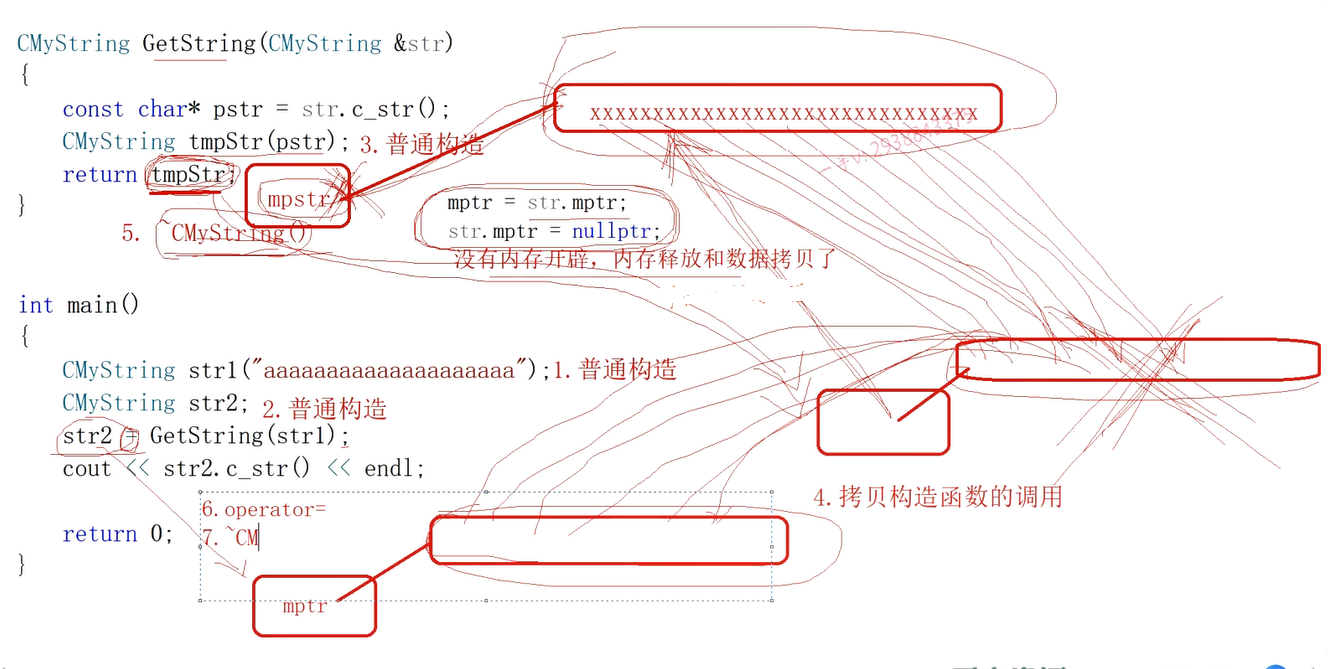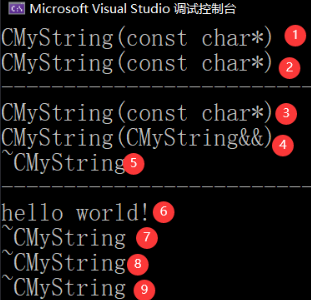C++的右值引用的应用
大约 5 分钟
C++的右值引用的应用
1、CMyStirng代码的问题分析
class CMyString
{
public:
CMyString(const char* str = nullptr)
{
cout << "CMyString(const char*)" << endl;
if (str != nullptr)
{
mptr = new char[strlen(str) + 1];
strcpy(mptr, str);
}
else
{
// 最少都初始化只有一个\0的字符串,使得不需要对字符串判空操作
mptr = new char[1];
*mptr = '\0';
}
}
~CMyString()
{
cout << "~CMyString" << endl;
delete[]mptr;
mptr = nullptr;
}
// 带左值引用参数的拷贝构造
CMyString(const CMyString& str)
{
cout << "CMyString(const CMyString&)" << endl;
mptr = new char[strlen(str.mptr) + 1];
strcpy(mptr, str.mptr);
}
// 带左值引用参数的赋值重载函数
CMyString& operator=(const CMyString& str)
{
cout << "operator=(const CMyString&)" << endl;
if (this == &str)
return *this;
delete[]mptr;
mptr = new char[strlen(str.mptr) + 1];
strcpy(mptr, str.mptr);
return *this;
}
const char* c_str()const { return mptr; }
private:
char* mptr;
};
CMyString GetString(CMyString& str)
{
const char* pstr = str.c_str();
CMyString tmpStr(pstr);
return tmpStr;
}
int main()
{
CMyString str1("aaaaaaaaaaaaaaaaaaaa");
CMyString str2;
str2 = GetString(str1);
cout << str2.c_str() << endl;
return 0;
}
CMyString(const char*)
CMyString(const char*)
CMyString(const char*)
CMyString(const CMyString&) // m1
~CMyString
operator=(const CMyString&) // m2
~CMyString
aaaaaaaaaaaaaaaaaaaa
~CMyString
~CMyString
m1位置处,是GetString返回时候调用拷贝构造返回main函数栈帧的临时对象,这里会做,因为对象存放一个动态开辟的char数组。并且拷贝完立马就释放了。
m2位置是main函数上临时对象给str2拷贝赋值,等于说又做一次,并且拷贝完立马就释放了。
这两次操作的,我们

解决方法
[引用 | 张威的编程学习笔记 (gitee.io)](https://iszhwei.gitee.io/ccpp/02 c__基础/引用.html#右值引用)
右值引用、实现接收右值的拷贝构造和拷贝赋值函数(移动构造和赋值)
临时对象是右值
添加的函数如下:
// 带右值引用参数的拷贝构造,移动构造
// 将右边的资源直接窃取过来
CMyString(CMyString&& str) // str传入的就是右值亦称为将亡值
{
cout << "CMyString(CMyString&& str)" << endl;
mptr = str.mptr;
str.mptr = nullptr;
}
// 带右值引用参数的赋值重载函数,移动赋值
// 将右边的资源直接窃取过来
CMyString& operator=(CMyString&& str)
{
cout << "operator=(CMyString&& str)" << endl;
if (this == &str)
return *this;
delete[] mptr;
mptr = str.mptr;
str.mptr = nullptr;
return *this;
}
CMyString(const char*)
CMyString(const char*)
CMyString(const char*)
CMyString(CMyString&& str)
~CMyString
operator=(CMyString&& str)
~CMyString
aaaaaaaaaaaaaaaaaaaa
~CMyString
~CMyString
两次拷贝全都走移动构造和移动赋值,全都是进行指针指向的改变,而不是内存空间的重新分配,这样必然可以极大的提高效率
operator+()效率问题
CMyString operator+ (const String &lhs, const String &rhs)
{
char* ptmp = new char[strlen(lhs._ptr) + strlen(rhs._ptr) + 1];//内存泄漏
strcpy(ptmp, lhs.mptr);
strcat(ptmp, rhs.mptr);
return CMyString(ptmp);
}
如果上面这样写会导致,因此不能直接返回临时对象
CMyString operator+(const CMyString &lhs, const CMyString& rhs) {
char* ptmp = new char[strlen(lhs.mptr) + strlen(rhs.mptr) + 1];
strcpy(ptmp, lhs.mptr);
strcat(ptmp, rhs.mptr);
CMyString tmpStr(ptmp);
delete[] ptmp;
return tmpStr;
//return CMyString(ptmp);
}
这样写虽然解决了内存泄漏问题,
解决办法
CMyString operator+(const CMyString& lhs,
const CMyString& rhs)
{
//char *ptmp = new char[strlen(lhs.mptr) + strlen(rhs.mptr) + 1];
CMyString tmpStr;
tmpStr.mptr = new char[strlen(lhs.mptr) + strlen(rhs.mptr) + 1];
strcpy(tmpStr.mptr, lhs.mptr);
strcat(tmpStr.mptr, rhs.mptr);
//delete []ptmp;
return tmpStr;//直接调用右值拷贝构造函数
//return CMyString(ptmp);
}
#include <iostream>
using namespace std;
class CMyString
{
public:
CMyString(const char* str = nullptr)
{
cout << "CMyString(const char*)" << endl;
if (str != nullptr)
{
mptr = new char[strlen(str) + 1];
strcpy(mptr, str);
}
else
{
mptr = new char[1];
*mptr = '\0';
}
}
~CMyString()
{
cout << "~CMyString" << endl;
delete[]mptr;
mptr = nullptr;
}
//带左值引用参数的拷贝构造
CMyString(const CMyString& str)
{
cout << "CMyString(const CMyString&)" << endl;
mptr = new char[strlen(str.mptr) + 1];
strcpy(mptr, str.mptr);
}
//带右值引用参数的拷贝构造
CMyString(CMyString&& str)//str引用的就是一个临时对象
{
cout << "CMyString(CMyString&&)" << endl;
mptr = str.mptr;
str.mptr = nullptr;
}
//带左值引用参数的赋值重载函数
CMyString& operator=(const CMyString& str)
{
cout << "operator=(const CMyString&)" << endl;
if (this == &str)
return *this;
delete[]mptr;
mptr = new char[strlen(str.mptr) + 1];
strcpy(mptr, str.mptr);
return *this;
}
//带右值引用参数的赋值重载函数
CMyString& operator=(CMyString&& str)//str引用的是临时对象
{
cout << "operator=(CMyString&&)" << endl;
if (this == &str)
return *this;
delete[]mptr;
mptr = str.mptr;
str.mptr = nullptr;
return *this;
}
const char* c_str()const { return mptr; }
private:
char* mptr;
friend CMyString operator+(const CMyString& lhs,
const CMyString& rhs);
friend ostream& operator<<(ostream& out, const CMyString& str);
};
CMyString operator+(const CMyString& lhs,
const CMyString& rhs)
{
//char *ptmp = new char[strlen(lhs.mptr) + strlen(rhs.mptr) + 1];
CMyString tmpStr;
tmpStr.mptr = new char[strlen(lhs.mptr) + strlen(rhs.mptr) + 1];
strcpy(tmpStr.mptr, lhs.mptr);
strcat(tmpStr.mptr, rhs.mptr);
//delete []ptmp;
return tmpStr;//直接调用右值拷贝构造函数
//return CMyString(ptmp);
}
ostream& operator<<(ostream& out, const CMyString& str)
{
cout << str.mptr;
return out;
}
CMyString GetString(CMyString& str)
{
const char* pstr = str.c_str();
CMyString tmpStr(pstr);
return tmpStr;
}
int main()
{
CMyString str1 = "hello ";
CMyString str2 = "world!";
cout << "--------------------------" << endl;
CMyString str3 = str1 + str2;
cout << "--------------------------" << endl;
cout << str3 << endl;
}

分析下面打印什么
int main()
{
CMyString str1 = "aaa";
vector<CMyString> vec;
vec.reserve(10);
cout << "----------------------------------" << endl;
vec.push_back(str1); // 调用左值引用的拷贝
vec.push_back(CMyString("nnn")); // 调用构造 和 右值引用的拷贝
cout << "----------------------------------" << endl;
}
匹配左值: 调用左值引用的拷贝构造;
匹配右值: 调用右值引用的拷贝构造;
CMyString(const char*)
----------------------------------
CMyString(const CMyString&)
CMyString(const char*)
CMyString(CMyString&& str)
~CMyString
----------------------------------
~CMyString
~CMyString
~CMyString